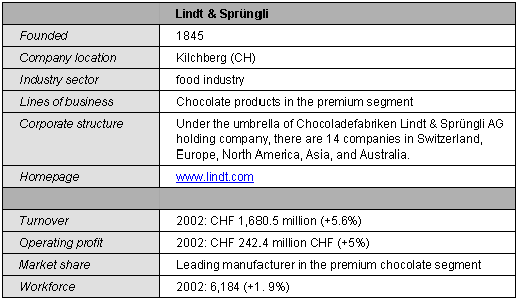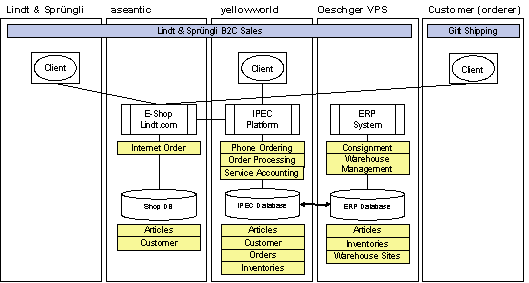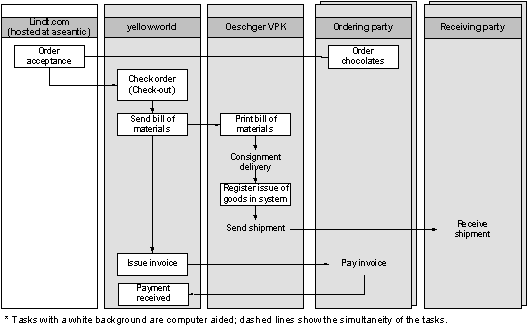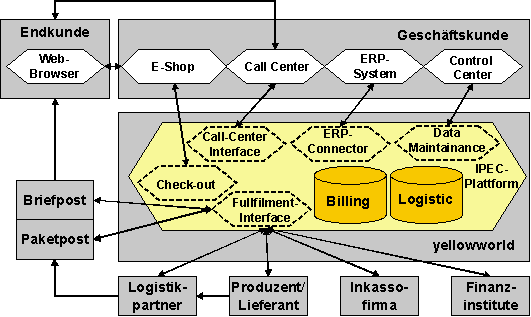Developing a new distribution channel at Lindt & Sprüngli through outsourcing the fulfilment
Lindt & Sprüngli passed the handling of its end customer business to yellowworld. The target group of these business activities are mainly customers who want to send Lindt products as gifts and would like to do this in an easy and uncomplicated way.
Together with its partners, the E-Fulfilment subsidiary of the Swiss Post Office operates other access channels for end customers besides the Internet channel (www.lindt.com). This includes telephone and written orders using the yellowworld call centre and the Lindt & Sprüngli FlightStore.
Table of Contents
1. The company2. E-Business strategy
3. Integration solution
Business perspective, Outsourcing, Process view, Channels, Goods returned, Application view, Technical view, IPEC, E-Business model
4. Implementation
5. Operation
Costs and benefits, Costs, Work involved, Profitability
6. Success factors
1. The company
Background:
The Lindt & Sprüngli Group (for brevity subsequently referred to as Lindt) is one of the world's leading companies with head offices in Kilchberg (CH) and a total of 14 subsidiaries in Europe and overseas. The group specializes in the manufacture of high quality chocolate products thereby continuing the tradition of the company’s founder who helped establish the reputation of Swiss chocolate through the development of new production methods in the 19th century.
Tab.1.1: Brief company portrait

Industry Sector, Product, Target Group and Corporate Vision:
The Company purposefully cultivates the premium segment. It emphasizes tradition and quality in its chocolate products, as found for example in the established image of the “Maîtres Chocolatiers” prominent in its advertising. At the same time, Lindt makes use of product innovations such as its lebkuchen pralines, which were first offered in the 2002/2003 Christmas season.
In contrast to the trend in the food industry, the uninterrupted demand for Lindt chocolates has allowed the company’s turnover and profit to increase. Market share has slightly increased in those countries that are important for the industry, i.e. Germany, France and Italy.
Generally, chocolate products are distributed to consumers through wholesalers and retail outlets.
2. E-Business strategy
E-Business areas of application in the company:
In the year 1995, when Lindt celebrated its 150 year anniversary by sending a chocolate gift to every Swiss household, they had the idea to open up a distribution channel to customers in addition to the traditional distribution through wholesale and retail outlets. That way, working customers in particular who have little time would be offered the possibility to send Lindt products as gifts in an uncomplicated way.
In September 1997, the Swiss postal service began handling this business for Lindt. Post offices displayed order cards to initiate particular orders. The products were paid for directly at the counter. Finally, the ordered chocolates were packaged by the warehouse specialists Oeschger VPS and delivered to the address on the order card.
The partners saw that combining various access channel was a prerequisite for the economical success of the offer. As a result, customers could place orders via a simple web form at www.chocogramm.ch, telephone a call centre or make a written order. Processing the order was similar to post office sales. The order was cleared by issuing an invoice or debiting a credit card or a post office account.
The procedure via the post office was time consuming and expensive. The paper-based order processing caused waiting times and tied up much of personnel resources. In addition, it was comparatively costly to educate all the tellers for this process.
Lindt & Sprüngli and yellowworld therefore decided to offer the gift service via an iInternet shop. The first solution was launched in summer 2001 under the brand name Chocogramm (www.chocogramm.ch).
At the beginning of 2002, a new shop was launced on the company’s internet website (www.lindt.com). The shop is internationally available. Individual country companies such as Germany and the USA have their own shop solutions. The new solution not only offers increased functionality, it also links the offer more closely to the Lindt brand.
Partners:
Fulfilment partners
Yellowworld (www.yellowworld.ch) is a subsidiary of the Swiss postal service that specializes in operating outsourcing solutions.
With 60 employees, the company provides services for about 400 customers in the areas of information logistics (e.g. order entry, dispatching transport orders to loaders, order tracing, and support) and service accounting (e.g. issuing invoices and collections). Yellowworld combines traditional postal services with new information-supported services. In the process, the Company accesses a network of external and internal partners.
As a full-service provider, yellowworld supports the analysis, design and implementation of customised solutions and runs them for the customer as an outsourcer.
As general contractor, yellowworld takes over fulfilment of the entire B2C business for the Lindt & Sprüngli Group via the internet (www.lindt.com), a call centre operated for Lindt and, for distribution of its products, via a FlightStore. FlightStore offers flight passengers the opportunity to order selected merchandise on board using the seat displays.
Based on yellowworld’s core expertise, Lindt decided that the entire fulfilment solution could be outsourced by working together with yellowworld and its partners. That meant that all activities – starting with receiving orders through various channels (multi-channel), continuing with the logistics process and ending with the payment guarantee – could be outsourced.
Logistics partner (Oeschger VPS)
Warehousing and consignment services are provided by Oeschger VPS (www.oeschgervps.ch), a specialist in small consignments and shipping to end consumers.
Oeschger VPS is a logistics partner of yellowworld and was chosen for the Lindt solution because of its experience in this product field.
Other yellowworld business partners
Many more companies are involved in handling the end-user business, one of which, for example, is the Swiss postal service and its worldwide partners for shipping: PostFinance, for service accounting via post office accounts and intrum justitia for collection.
aseantic
aseantic (www.aseantic.com) runs the website with the shop solution on behalf of Lindt. The fulfilment process described in the framework of this case study is coupled with online sales in the web shop for distribution in the internet.
3. Integration solution

Fig. 3.1: Information flow and integration
Business Perspective:
Lindt outsourced the handling of its end customer business (business to consumer, B2C) to yellowworld. The focus of the offer to end customers is the delivery of gift packages The gift offer must differentiate between customers who place the order and customers who receive the order as a gift. The offer is effective worldwide, but it is mainly used for shipping to Switzerland (66%), to Europe/North Africa (17%) and the U.S. (17%).
As well as the internet channel, additional access channels are available to the customer making an order such as the call centre for phoned and written orders using order cards and the FlightStore. Outsourcing simplifies the practice of making offers to end customers for Lindt because yellowworld purchases merchandise in large volumes (pallets) like a wholesaler. These become the property of the postal service upon delivery by Lindt. However, the merchandise will be taken back if, for example, if it has not been sold 6 months before the expiry date.
The product range comprises 10 – 12 products and is jointly defined annually, with the end price being set by Lindt. yellowworld pays its own costs and its partners. The risk of not receiving payment from the customer making the order (insolvency risk) is carried by yellowworld. Yellowworld receives compensation from Lindt for operating a call centre based on usage (according to length of conversation).
Because this is a volume business, operation for the company is only profitable from a turnover volume of CHF 1 million, which represents approximately 30,000 orders with an average volume of CHF 30 to CHF 40. The highest order volume is generated annually through one to three promotions, for example using the UBS Key Club, and on “gift” days such as Valentine’s Day, Mother’s Day and Christmas. Marketing the end customer offers through Lindt is therefore vital for visibility and sales success.
Process View:
The end customer business of Lindt & Sprüngli is handled by the following processes:
Product range adjustments
Lindt and yellowworld agree upon the product range once a year for the coming year. Changes to the six to ten product families are manually entered into the yellowworld and Oeschger VPS systems.
Advertising
Advertising the offers and conducting the promotions is the responsibility of Lindt & Sprüngli.
Warehouse management
Oeschger VPS is contracted by yellowworld to manage warehouse operations. The dispatchers order the necessary products throughout the year from Lindt and store them. Lindt provides the packaging material for the shipment of chocolate that is also stored with Oeschger VPS. Inventory is compared once a week with yellowworld and, if necessary, manually corrected in the yellowworld or Oeschger systems.
Customer orders
Most orders are sent as gifts. Lindt products are offered through the following channels:
- via the internet (www.lindt.com),
- by telephone to the call centre using a 0900 number (cost to the caller is CHF0.50/min),
- in writing with coupons or order cards from promotions
- via the Lindt & Sprüngli FlightStore
Customers are made aware of the usual delivery times. There is no guarantee that the products will be delivered punctually.
Orders from the internet and the FlightStore are put directly into the system. All other orders are processed manually by the call centre employees using the call centre interface.
Orders are set by formatted e-mails to Oeschger VPS on week days, four times daily at specific times. The e-mail printout provides the packing slip (incl. the address label) and the text for any chosen greeting card to the recipient. Afterwards, the issued products are manually entered into the system.
The most frequent method of payment is by invoice. Figure 3.2 illustrates the process for an internet order with invoicing.

Fig. 3.2: Processing an internet order with invoicing
Goods returned:
According to the persons responsible, products are rarely returned. The reasons for returned products could be:
- The package is returned because of an incomplete or incorrect delivery address
- The person receiving the gift or making the order complains that a delivery arrived late
- The person receiving the gift is not satisfied with the quality of the chocolates.
The most frequent reason for returned products is an incomplete address. In this case the delivery is returned to logistics specialists Oeschger VPS. The customer who made the order receives a credit voucher from yellowworld.
Although in their general terms of business, Lindt & Sprüngli do not guarantee the customer a timely postal delivery, there are individual complaints. In exceptional instances, for reasons of fairness, the customer is sent a replacement delivery.
In rare cases, when the customer receiving the gift feels that the chocolates do not meet the expected standard, Lindt & Sprüngli handles the case directly. Usually, in this case the customer receives a replacement delivery.
Reporting
yellowworld handles the customer database for the end-user business for Lindt. Lindt receives weekly and monthly turnover reports and analyses according to specific criteria such as customer structure.
Application View:
The system-related support of the described processes is performed by three systems: the Lindt.com shop solution, the yellowworld IPEC platform, and the ERP system at Oeschger VPS.
To place an order using the internet channel, the customer uses the web gift shop at Lindt.com. The check-out is reached once the order data is entered. The customer's data is automatically transferred to the yellowworld system via HTTPS (Hypertext Transfer Protocol Secure) and is checked there (for the customer’s credit card and the ability of yellowworld to deliver, for example). The customer receives notification that the order has been accepted. Orders from the call centre are entered directly using a call centre interface on the IPEC platform.
As the amount of data is small and the product range is limited and relatively static, it was decided against further integration of systems (such as synchronisation of master data).The IPEC platform, for example, would be capable of supporting automated data exchange between yellowworld and Oeschger. Because of the small number of transactions, however, the persons in charge decided in favour of communication via e-mail. Article master data, orders and inventories are manually entered into the respective systems, which means that the information in the databases ultimately “replicated” by hand. In the same way, any delivery bottlenecks that may occur are reported to the shop operator who can then place the relative information on the website or remove the products from the catalogue (see Figure 3.1).
Technical View:
The gift shop hosted by aseantic is based on Microsoft technology, which includes components such as MS SQL server, MS BizTalk Server and MS Commerce Server 2000, among others.
The yellowworld transaction platform, IPEC (Integrated Platform Electronic Commerce) is capable of integrating partner systems using various interfaces (HTTPS, FTP, SMTP), as realised for the gift shop in the case presented. The data is encrypted using SSL (Secure Socket Laver Protocol).
The component model serves as the basis concept for setting up the IPEC platform. This permits integration of standard functions in the general solution. The illustration below shows the standard functions of IPEC in an integrated E-Business model. The arrows clearly show the information flow between the individual elements of the model. In the centre are the service accounting components and information logistics components of IPEC. IPEC is already used in this form by numerous customers for handling their businesses.
The component model serves as the basis concept for setting up the IPEC platform. This allows for the integration of standard functions in the total solution.

Fig. 3.3: Standard Functionality IPEC [Endkunde: End Customer, Geschäftskunde: Business Customer, Briefpost: Letter Mail, Paketpost: Packet Mail, Logistikpartner: Logistics Partner, Produzent/Lieferant: Producer/supplier, Inkassofirma: Collections Company, Finannzinstitute: Financial Instutution]
During the setup of the IPEC-IT infrastructure, the following aspects were important:
- A redundant, multi-location layout of the entire hardware infrastructure
- Failsafe networks
- Double or multiple layout of the infrastructure
- Tested and certified general environment, incl. the underlying active and passive communication components
- Tested and certified infrastructure
- Provision of separate environments for development, integration and production
The IPEC platform is operated at two different locations. The architecture involves three layers with the databases being stored on the centralised data management platform. The division into three layers was chosen primarily for security reasons.

Figure 3.4: Short description of the layer model for the complete solution
4. Implementation
For the implementation, a differentiation must be made between the website and the Lindt.com gift shop and the realization of the fulfilment solution. yellowworld is the general contractor for fulfilment and is responsible to Lindt as the integrator for its partner network. yellowworld itself realised the technical support for this teamwork.
yellowworld is involved in the decision-making process in the design of the E-Shop at Lindt.com, which mainly involves coordinating the check-out.
The shop offers its services worldwide. Exceptions for ordering are countries with their own shop solutions. However, shipments are also made to these countries. A challenge during the technical implementation therefore lay in accomodating international standards, which increased the complexity of the project. Lindt & Sprüngli grants its subsidiaries a large degree of autonomy. Specifically, it was necessary to convince the subsidiaries of the benefits of the solution and to take their needs into due consideration.
5. Operation
All involved parties are responsible for the maintenance of their own systems.
Costs and Benefits:
Using the gift shop, Lindt can directly address end customers in situations in which traditional distribution through the retail market cannot offer a comparable service package – sending gifts with greeting cards, for example. This offer strengthens the brand name in the minds of customers. This is supported by product bundling, for example Lindt chocolates + music CD, which is only available through this channel. The multi-channel offer creates additional benefits for customers as it makes it possible for choose the most convenient method of making an order.
Outsourcing the fulfilment made it possible for the chocolate manufacturer to make internal use the familiar delivery process that was tailored to wholesale outlets (using pallets as a delivery unit). The outsourcing specialist yellowworld, which acts as an integrator, can provide this service better and cheaper with its partner network, including the specialists in small consignments Oeschger VPS.
The costs of the fulfilment process are paid for with the margin agreed upon with Lindt. The profitability threshold is CHF 1 million. During the implementation of the solution, one person from yellowworld was in charge of supporting the process. Today the work involved is approximately 30 to 40% of a fulltime position.
The work involved for implementing the solution and testing it amounted to a total of approximately 10 project days. Included in the project was the integration of the web shop into the IPEC platform (check-out) and the forwarding of the orders to the logistics partner by formatted e-mails.
Profitability:
It was Lindt’s and yellowworld’s objective to achieve turnover in the medium term that guaranteed cost-effective operation of this distribution channel. It has been shown that turnover is strongly affected by promotions and gift-giving days. Communicating the offer to customers had a tremendous effect on the profitability of the solution. The combination of various access channels is another important prerequisite for the profitability of the solution in the opinion of the involved parties, because it doesn't tie the customer to a specific medium (the Internet for example).
6. Success factors
Specialities of the solution:
The solution described is characterised by the following special features:
- yellowworld and its partners took over the handling of the end customer business for Lindt & Sprüngli, including assuming the risk of insolvency.
- The offer is aimed at a life situation (gift service), which is not offered to this extent to the end customer via the retail market. This is supported by exclusive product bundles.
- The customer can use different access channels to the gift service. This multi-channel offer creates added value for customers, since it gives them the choice of the most convenient methods possible of ordering, and even addresses customers that have no internet access.
- Integration of the systems was kept to a minimum of what was technically possible because of the limited transaction volume. Changes (e.g. in master data and inventories) are mainly done manually.
Lessons Learned:
An essential success factor for solutions like the Lindt gift shop is advertising the offer. This is shown by the high order volumes following promotions. Continuous communication of the offer increases awareness of the offer. For example, there is a reference to the online shop on all Lindt products. Customer appeal is not only promoted by the specially tailored product bundles but rather by the offer of different access channels.
The offer’s profitability is dependent on the number of units sold. For smaller volumes, the solution cannot be profitable because the technical system integration was only implemented where it made business sense.
The most important conditions for successful partnership are a common understanding of the planned business model and the corresponding development of clear agreements. Here, risk distribution is regulated in addition to defining the services and the price.
Thanks to the outsourcing to yellowworld, Lindt was able to tap into the B2C market. One test opened up a new, profitable line of business. This line of business must be consistently developed with marketing activities just like the other lines of business. Consequently, it is important to continue to develop the business within the framework of the corporate strategy.



